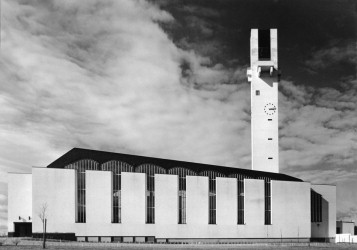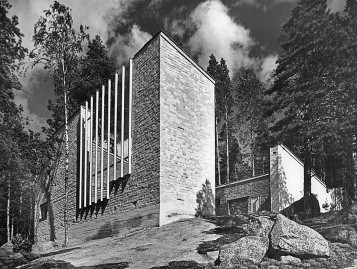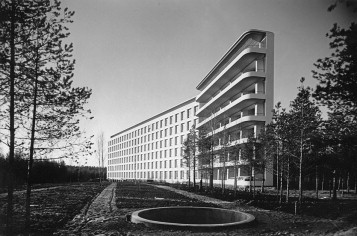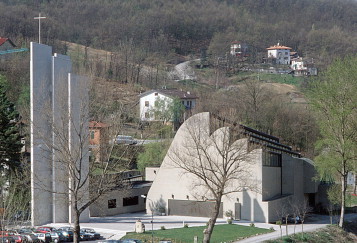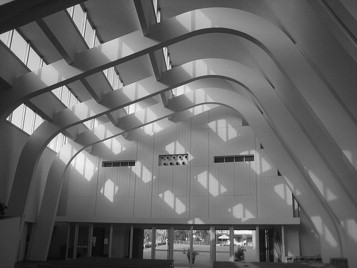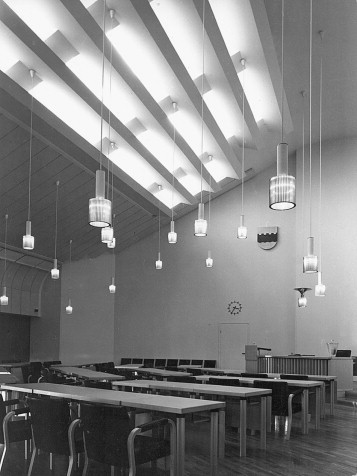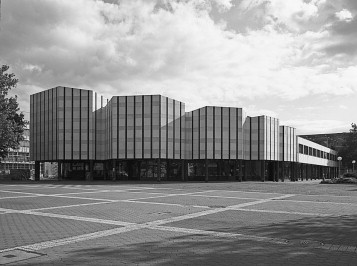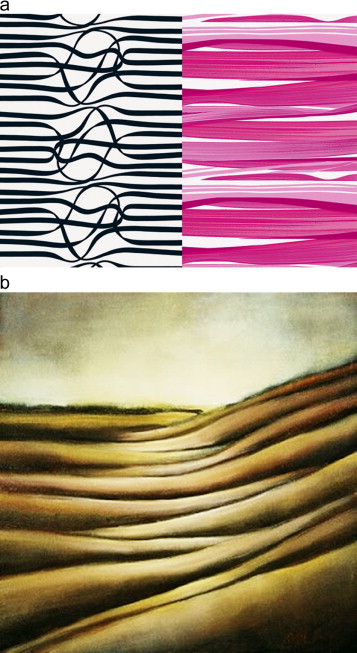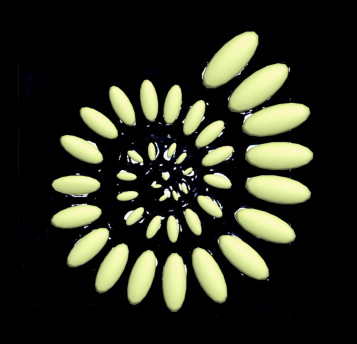Abstract
Rhythm in design, as explored in this research, is proposed to be the result of cognitive performance generated stylistically by creators and recognized consciously by beholders. This study describes the phenomenon of rhythm; how it is created; the factors that comprise rhythm; the types of rhythms created by human cognition of repetition, and why repetition is recognized as a part of human cognition. Images of seven buildings designed by Alvar Aalto are used to demonstrate the creation and expression of rhythm in building compositions. Evidence gathered in this research explains that rhythm in design is a result of the design method consciously applied by human cognition of repetition. Rules of generating the phenomena of rhythm are also summarized. Designers could apply these rules to generate harmonious patterns through the effective usage of repetition. In sum, rhythm is ingrained in the human conscience and therefore should be a key component of design applied universally.
Keywords
Rhythm ; Repetition ; Phenomenology ; Design cognition ; Design thinking
1. Introduction
Design is a product of human cognition. Every designer has their own way of thinking, each with a different background and approach to design that generate unique, individual design results. Among different products done by different designers, some phenomena do recur in the appearance of certain forms. Some of them are visually appealing and attractive due to the visual expression of specific qualities. These visual qualities are accomplished by special compositional methods applied in the process of creation. Some of these phenomena could be seen, measured, and analyzed to get more understanding on both the quality of design and on the process of design creations. Rhythm in design that has a clear pattern recognized by human perception is one example of the phenomena occurring in the design products and is the focus of this research.
It is interesting to investigate the factors that cause rhythm to appear in design. In fact, rhythm is not just one of the design methodologies used for form generation, it also is the result of cognitive processing and only comprehended through human perception. In this article, concepts of design cognition and perception are discussed from an approach treating design as a way of organizing information through human reasoning. Theoretically speaking, design cognition is a part of the human cognitive process of gathering, recognizing, collecting, memorizing, recalling, and processing design information by designers (Chan, 1990 ; Chan, 2008 ); whereas perception is another part of the human cognitive process of recognizing and interpreting external information obtained through sensual input by beholders. Explained from the point of view of cognition, rhythm could be seen as an entity, generated by designers through some cognitive processing, and recognized visually as appearing in design products. Rhythm, as created by the processes and revealed in the products of human cognition, is ingrained in human consciousness and therefore should be a key component of design applied universally.
In this research, the definition of rhythm, how it is created, and why it is a part of human design cognition are explored through case studies. Even though rhythm is seen as a phenomenon, it has not been approached from a phenomenological point of view on what thing (i.e., rhythm) means (Brentano, 1995 ). Instead, the study quantifies positive facts and observable event that can be seen, measured, and be counted as facts, which is best described as a positivist perspective (Scharff, 1995 ). Thus, rhythm as a product of design cognition is a phenomenon that we believe can be seen, measured, and analyzed to get more understanding on the quality of design and the process of design creation. Studies in this approach would generate more theoretical and scientific contributions to the fields of design studies and design thinking. However, not many studies have been done in this regard. This project takes a lead in this direction.
2. Phenomena and definition of rhythm
Rhythm has been defined in various fields of arts and performing arts,1 sharing the central meaning of a patterned recurrence, repetition, or movement in actions or artifacts. In design, rhythm is the regular, harmonious recurrence of a specific element, often a single specific entity coming from the categories of line, shape, form, color, light, shadow, and sound. If a designer chooses elements from these categories and creates some composition of these elements, then a motif or pattern is generated. The designer could also repetitively apply a single element, a composed motif or pattern at regular mode. As long as a visually or auditory harmonious composition is generated, through repetition, a rhythm is created. Of course, a hybrid composition of such entities across categories should also serve the same purposes. However, without having or experiencing the comfortable visual or auditory results of element repetitions, rhythm would not exist. On the other hand, designers working with singular massing and uniform detailing strategies might have produce different outcomes.
3. Factors causing rhythm
Rhythm, as defined, is created by repetition. Repetition is a cognitive way of processing information. In language arts, repetition is a persuasive strategy used to affect or coordinate attitudes, especially when terms are used repeatedly in question begging form (Boisvert, 2011 ). In writing, repetition is a rhetorical device used to emphasize a point, notion, or meaning. There are a number of methods used in writing, for example, the repetition of a single word with no words in between (palilogia); or a word in various places throughout a paragraph (conduplicatio), or used a word at the end of a sentence and then used it again at the beginning of the next sentence (anadiplosis); or repeating a word or phrase at the beginning (anaphora), middle (mesodiplosis), or the end (epistrophe) of every clause (see note 2 on rhetorical devices).2 Thus, applying different methods of repetition, different results of emotional inspiration are generated, which demonstrate that language is an instrument or tool for serving certain purposes (Boisvert, 2011 ). In music, the repetition of a fixed rhyme, beat, or melody has also been used to generate music (Yeston, 1976 ).
In learning, the practice of learning by repetition, which is called rote learning or rehearsal, is another form of cognitive strategy. Rehearsal serves the purpose of maintaining a small set of items in short-term memory by repetition, and any information in short-term memory is transferred to long-term storage to some degree throughout its stay in short-term memory (Waugh and Norman, 1965 ; Atkinson and Shiffrin, 1968 ), which helps in human learning. More rehearsal or repetition of items in practice would improve our skill and memory. Specifically, repeated exposure to a piece of information does provide the opportunity for more elaborate processing or extent of semantic processing of the stimuli. This explains that repetition is a cognitive process.
From the point of view of cognition repetitively using the same set of features across many projects in architecture design (Chan, 2000 ; Chan, 2001 ) would inherently manifest a signature style. For instance, Frank Lloyd Wright in his designs repeatedly applied the features of a low pitch roof, centered fireplace, a band of casement windows, continuous bands of window sill, extended terraces with low parapet and coping, watertable, corner blocks, planting urns, massive brick chimney, continuous wall between sill and watertable, overhanging eaves, and symmetric side facade in the houses he designed from 1900 to 1910. These features have been used by scholars to exclusively define Wrights prairie house style (Chan, 1992 ). Thus, repetition defines a design style.
In everyday life, people often repeat the same routine, repeatedly drinking the same brand of beverage, navigating the same route to the same destination, or following the same schedule every day to run errands. After the same things executed for more than thousands of times, they would be turned into automatic skills of their procedural knowledge (Anderson, 1980 ). Thus, a cause of repetition can be in the automatic execution of skills and repetition becomes a cognitive procedure for accomplishing things.
These research examples, conducted and explored in different fields, do demonstrate that repetition is the cognitive strategy used to persuade belief (in rhetoric), to emphasize a notion (in literature), to improve learning (in psychology), to generate a style (in design); and is the human cognitive operation used in everydays life. By the same token, in fields of design, repetition is also one of the cognitive mechanisms used from applying a basic module together with a set of rules to create a pattern that expresses rhythm in design. Reasons for causing repetition in design could either be the intentional plan or the well practiced procedural knowledge that was automatically applied to create similar patterns. Thus, repetition and methods of application are the factors causing rhythm, yet its basic driving force is repetition.
4. Phenomenology of rhythm
Phenomenology of rhythm relates to the quality of repetition and how perceivers observe the results. Rhythm, by definition, is repetition and repetition could automatically create an order to the whole design. Such a created order is the character of rhythmic phenomena. Analytically speaking, rhythm generates some regularity, simplicity, balance, and order of composition that allows the design to develop a nature of consistency. The consistency would make the view easy to understand. In fact, after the rhythmic pattern is recognized, the whole design could be clearly comprehended. Therefore, repetition with similar movement and/or transformation rules would always generate an ordered pattern. Such created patterns could call viewers' visual attention to put more cognitive process for investigating the semantic context of the pattern.
5. Rules creating rhythm in design
Rules that create rhythm can be described as a set of operating procedures applied to create forms. In a design, there are many functional design issues that must be considered and rhythm may or may not be one of them. Yet, regardless of whether rhythm has been considered as a design issue or not, as long as a rhythm appeared in a building design, its phenomena demonstrate the effort of thinking about specific arrangements. Here are the examples explaining the rules applied for creation, which are categorized by the nature of repetition.
- Repetition in forms (regular rhythm): A regular rhythm is created by repeating an element through regular recurrence (rule 1–1); and the repeated elements are often similar in size or length (rule 1–2). In graphic design, it could be a shape that re-occurs by some intervals or in certain patterns to constitute a design. In architectural design, it could be the repetition of a single wall unit or vertical opening in Figure 1 ; Figure 2 , or balcony unit in Figure 3 to form a façade, or simple shape to composite the roof in Figure 4 . Figure 1 , Figure 2 , Figure 3 ; Figure 4 were designs done by Alvar Aalto.
|
|
|
Figure 1. Church of the Plains by Aalto, 1951–1960. Note : Photo: Kalevi A. Mäkinen, Alvar Aalto Museum. Approximately 1960. |
|
|
|
Figure 2. Muuratsalo, Experimental House by Aalto, 1952–1954. Note : Photo: Eino Mökinen, Alvar Aalto Museum. |
|
|
|
Figure 3. Paimio Sanatorium by Aalto, 1928–32. Photo: Photographer unknown, Alvar Aalto Museum. 1930s. |
|
|
|
Figure 4. Riola Church by Aalto, 1966–1980. Note : Photo: Maija Holma, Alvar Aalto Museum. 1997. |
- Repetition in structure (structure rhythm): A structure rhythm (rule 2) is created by combining beams and columns to form repetitive structural bays; and these structural elements are similar in size or dimensions to maintain the structural properties of equilibrium. Figure 5 was the Riola Parish Church designed by Aalto, which has repeated curved beam and column structure that creates rhythm in three-dimension.
|
|
|
Figure 5. Riola Church interior, Aalto, 1966–80. Note : Riola Parish Church interior is adapted from: 〈http://snyfarvu.farmingdale.edu/∼straaw/design2/project3/alvaraalto.html〉 . |
- Repetition in lights (reflective rhythm): A reflective rhythm (rule 3) is created by opening up a surface with a repeated regular module to let light in. The shadows casted on walls will also create a reflective rhythm. Figure 5 has light coming through the beams and casting shadows on the wall. Figure 6 is a design by Aalto that shows the repetition of supports and voids used to define rhythm.
|
|
|
Figure 6. Seinajoki Town Hall by Aalto, 1958–65. Note : Photo: Kalevi A. Mökinen, Alvar Aalto Museum. Approximately 1965. |
- Repetition in functions (spatial rhythm): Module spaces often recur to accommodate similar or repetitive functional requirements in building program, for instance, standardized units of guest rooms (hotel), classrooms (school), or patient rooms (hospital) used in various building typologies. Figure 7 is the Wolfsburg Cultural Center designed by Aalto, which has repeated similar volume showing different spaces. Figure 8 is another un-built project by Aalto applying similar concepts of spatial rhythm for an art museum in Iran. Thus, spatial rhythm (rule 4) is to repeat the similar shape of spaces attached with similar functionalities, but the dimensions of the shape could be changed regularly.
|
|
|
Figure 7. Wolfsburg Cultural Center by Aalto, 1958–62. Note : Photo: Harald Raebiger, Alvar Aalto Museum. 1993. |
|
|
|
Figure 8. Shiraz Art Museum, by Aalto, 1969–70. Note : Photo: Photographer unknown, Alvar Aalto Museum. |
- Repetition in movement (flowing rhythm): A flowing rhythm provides a motion of movement and is organic in nature (McClurg-Genevese, 2005 ). Figure 9 is the example of flowing rhythm in organic form. The method used to create flowing rhythm (rule 5) is to morph the element, but maintain the similar interval of movement and the same number of vertices and/or polygons of the element.
|
|
|
Figure 9. Flowing rhythm showing movements. Note : Flowing rhythm is adapted from: 〈http://www.writedesignonline.com/resources/design/rules/marimekko-spr08.jpg〉 , and 〈http://kelseyessig.blogspot.com/2009/03/rhythm-in-interior-design-also-may-be.html〉 |
- Repetition in process (iterative rhythm): A rhythm could be generated not only by regular recurrence of an element, but also by iteration to create comfortable visual result. Iteration, as used in computer programming, is the act of (rule 6) repeating the same process to approach a desired goal or result. Similarly, the same and simple actions are repeated in ballet dancing and ballroom dancing to match with certain melodies (as in waltz, tango, salsa, rumba, etc.). In music, sounds and silences are put together to form patterns of sound, which are beats that repeated steadily to create rhythm.
- Repetition in growth (progressive rhythm): On the other hand, rhythm could also be created (rule 7) by reverberating a shape or a form from a point and additively grow in a certain direction or follow a path (Ching, 1979 ). For instance, the form with rhythm could be generated in a radial or concentric manner about a point along a path with a gradual increased interval (see Figure 10 ); it could also be sequentially grown proportionally in size in a linear way; or it could be repeated randomly, but maintain the proximity and similarity of a form.
|
|
|
Figure 10. Progressive rhythm showing movements. |
6. Impacts of rhythm in design
Impacts of the phenomenon of rhythm to human perception could be considered and evaluated from different perspectives in different fields. In language, rhythm is accomplished by the repetition of using the same words or placing the same words or phrases in writing to achieve the purposes of convincing arguments. In all poetry, repetition of a sound, syllable, word, phrase, line, stanza, or metrical pattern is a basic unifying device to heighten emotional response and provide readers a sense of balance. In music, rhythm makes a music move and flow. In dance, as a form of nonverbal communication, rhythm guides the body movement as well (Goodridge, 1998 ).
In design, rhythm is made by form repetitions. As long as the basic element is repeated with an ordered sequence, a pleasant pattern will be created and would be identified as a rhythm. The phenomena of such a visual attraction will generate a pleasant environment for living, working, and recreation. Such a pleasant creation in product could be valid to justify good quality of design. Alvar Aaltos works are excellent examples. Shown in seven buildings (Figure 1 , Figure 2 , Figure 3 , Figure 4 , Figure 5 , Figure 6 , Figure 7 ; Figure 8 ), the repetition of major forms of balcony, window patterns, roof shapes, beam and columns, spatial volumes, and skylights had created poetic architectonic character of articulation in design. Given the strength of Aaltos oeuvre, the correlation between repletion and articulation is clearly explained.
7. Conclusions
Rhythm, in this study, is described as a patterned repetition of a motif, or formal element at regular or irregular intervals in the same or a modified form. If the form is generated by regular repetition, a consistent order is generated and an integrated whole is presented. If the form is generated at irregular intervals, the coherent order and grace level that result in the generation of rhythm might be diluted. This concept of difference between rhythmic patterns relates to the notion of the degree of rhythm, which needs further studies. On the other hand, a harmonious sequence or pattern of masses alternating with voids, a sequence of light alternating with shades or shadows, and a sequence of objects alternating with colors or textures all qualify as rhythm.
After all, rhythm is created by repetition. Repetition can be generated either through design intent or by automatic applications of well practiced design skills. Designers may not consciously look for the repetitive results created in the pattern, but might subconsciously address the articulated patterns in the design processes. However, the effect of rhythm created must be recognized through perception by viewers. As long as an element is repeated, a cluster of patterns will be generated, and a phenomenon of rhythm is, of course, created and recognized. Thus, rhythm should be a key component of design applied universally.
Acknowledgments
This research is an initiative of a study on phenomenology conducted at the College of Design starting from fall of 2011. Jasmine Brown participated in this project under the supports from the Ronald E. McNair Post-baccalaureate Achievement Program. Through guiding her progress on her Independent Design Studio and many discussions on the conceptual framework, this article emerges.
References
- Anderson, 1980 J.R. Anderson; Cognitive Psychology and Its Implications; W. H. Freeman, San Francisco, CA (1980)
- Atkinson and Shiffrin, 1968 R.C. Atkinson, R.M. Shiffrin; Human memory: a proposed system and its control processes; K.W. Spence, J.T. Spence (Eds.), The Psychology of Learning and Motivation, Vol. 2, Academic Press, New York (1968), pp. 89–195
- Boisvert, 2011 D.R Boisvert; Charles Leslie Stevenson; E.N. Zalta (Ed.), The Stanford Encyclopedia of Philosophy (2011) URL=http://www.digital-web.com/articles/principles_of_design/
- Brentano, 1995 F. Brentano; A.C. Rancurello, D.B. Terrell, L.L. McAlister (Eds.), Psychology from an Empirical Standpoint, Routledge, London and New York (1995)
- Chan, 1990 C.S. Chan; Cognitive processes in architectural design problem solving; Design Studies, 11 (2) (1990), pp. 60–80
- Chan, 1992 C.S. Chan; Exploring individual style through Wrights design; Journal of Architectural and Planning Research, 9 (3) (1992), pp. 207–238
- Chan, 2000 C.S. Chan; Can style be measured?; Design Studies, 21 (3) (2000), pp. 277–291
- Chan, 2001 C.S. Chan; An examination of the forces that generate a style; Design Studies, 22 (4) (2001), pp. 319–346
- Chan, 2008 C.S. Chan; Design Cognition: Cognitive Science in Design; China Architecture & Building Press, Beijing (2008)
- Ching, 1979 F.D.K. Ching; Architecture: Form, Space & Order; Van Nostrand Reinhold Co, New York (1979)
- Goodridge, 1998 J. Goodridge; Rhythm and Timing of Movement in Performance Drama, Dance and Ceremony, Jessica Kingsley, London (1998)
- McClurg-Genevese, 2005 McClurg-Genevese, J., 2005. The principles of design. Digital Web Magazine (online). Available from: 〈www.digital-web.com/articles/principles_of_design/〉 .
- Scharff, 1995 R.C. Scharff; Comte after Positivism; Cambridge University Press, Cambridge (1995)
- Waugh and Norman, 1965 N.C. Waugh, D.A. Norman; Primary memory; Psychological Review, 72 (1965), pp. 89–104
- Yeston, 1976 M. Yeston; The Stratification of Musical Rhythm; New Heaven, Yale University Press (1976)
Notes
1. Rhythm on dictionary, URL: 〈http://dictionary.reference.com/browse/rhythm〉 .
2. Rhetorical device, URL: 〈http://en.wikipedia.org/wiki/Repetition_(rhetorical_device)〉
Document information
Published on 12/05/17
Submitted on 12/05/17
Licence: Other
Share this document
Keywords
claim authorship
Are you one of the authors of this document?
